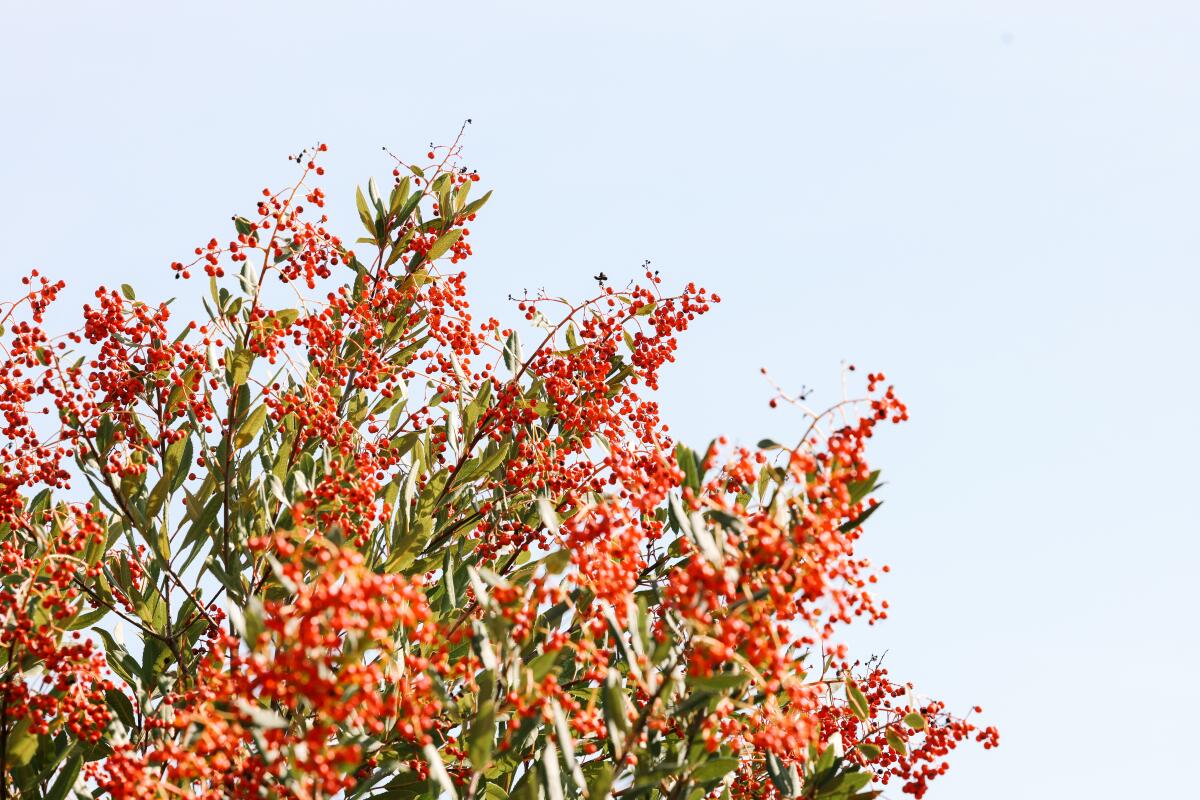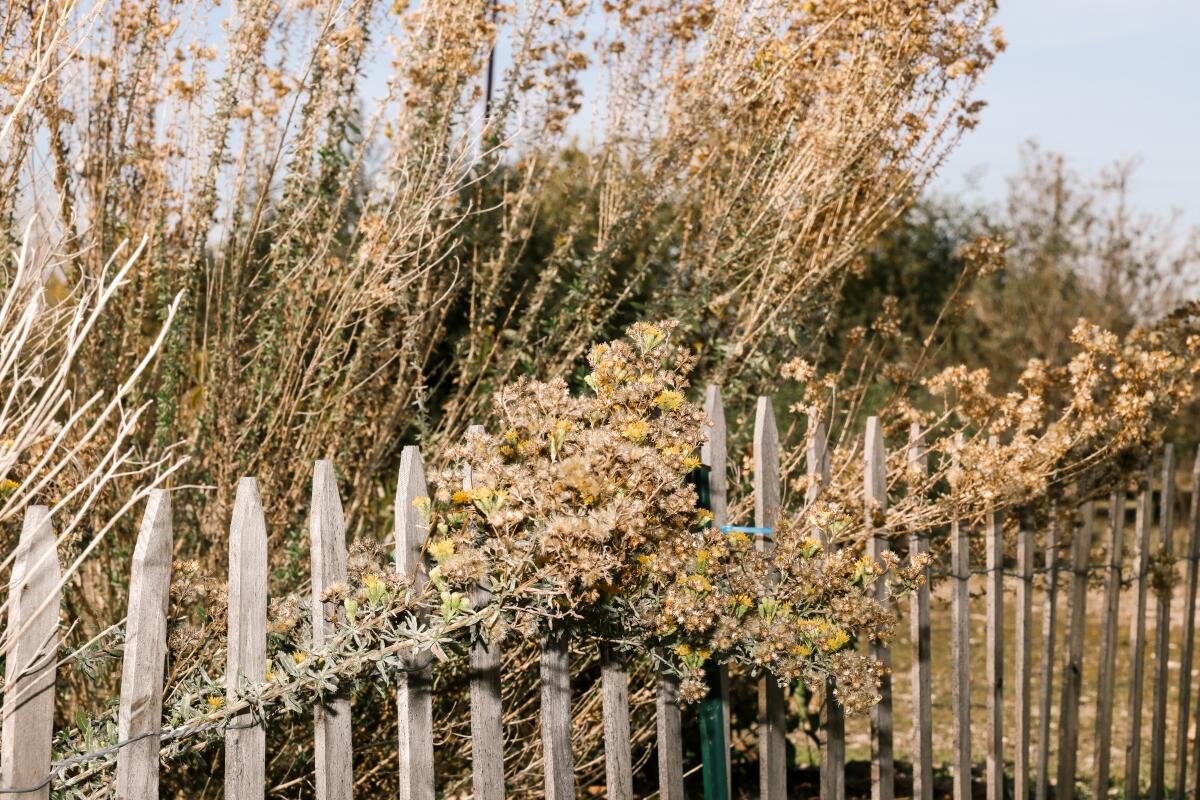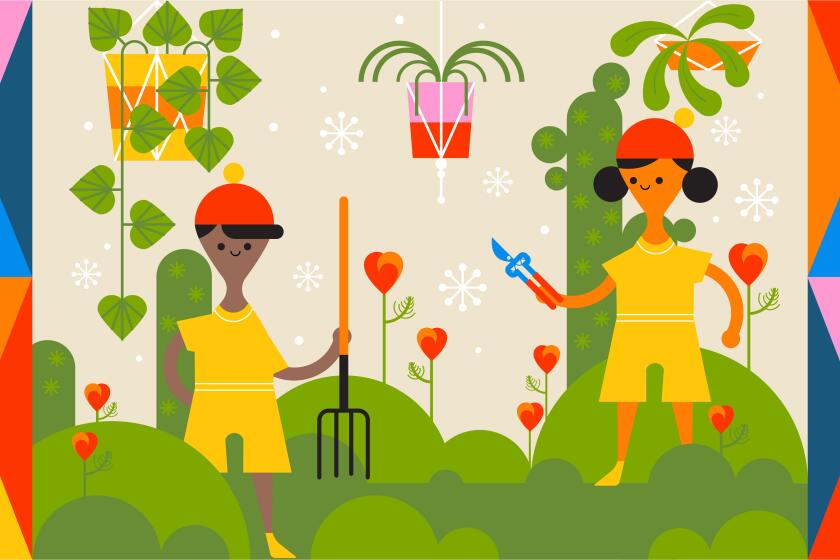Native plants are bringing new life to L.A.’s ravaged areas. Here’s how to help

‘Tis the season for restoration, right? Restoring ties with family and friends, restoring faith in our fellow humans, restoring hope that somehow love can prevail ....
.... and restoring habitat in the fire-and-human-ravaged areas of Southern California (which actually sounds a lot more doable than world peace).
Here’s the rub, however. Habitat work is pretty popular too. This article was supposed to be about the volunteer opportunities at Rio de Los Angeles State Park this month, planting native plants to restore habitat in a former rail yard. But those volunteer slots offered through the state parks volunteer calendar and restoration partner Theodore Payne Foundation, have already filled up for December, as have similar restoration projects at Kuruvungna Sacred Springs in Sawtelle and Los Angeles State Historic Park in Chinatown.
California native plants have many pros, but their potent scents are the biggest draw of all. Gardening experts share the most fragrant native plants.
So if you’re interested in “rewilding,” i.e. restoring native habitats to prevent erosion, capture rainwater and help native birds, insects and other animals survive, there are many upcoming volunteer opportunities this month and beyond. You can help restore some ecological balance to our region while learning from people who work with native plants every day to rebuild our fire-scarred hills and contaminated urban areas.

Rio de Los Angeles is a good example of how restoration works. This newish park sits in the middle of an industrial zone and residential area in Glassell Park, close to the eastern banks of the Los Angeles River. For 60-plus years, the site was known as Taylor Yard, one of the region’s largest railroad switching yards. When it closed in 1985, community groups pushed to turn the land into a park instead of more industrial space, said Luis Rincon, community engagement coordinator for California State Parks. Partnerships were formed between state and city, and Rio de Los Angeles State Park opened in 2007 with city-supervised playgrounds and athletic fields and state-managed hiking trails laced with native trees and shrubs.
Volunteers helped put those plants into the ground, and more than a decade later, it’s hard to realize you’re in an urban industrial area. The trails are lined with large sycamore, black walnut and cottonwood trees. There’s a scent garden filled with fragrant sages created by landscape designer Margaret Oakley Otto, tall sugar bush and toyon shrubs covered with berries and the dried remains of summer’s wildflowers.
Looking to buy for a new gardener or plant lover? Our holiday gift guide features the best tools and accessories to boost a beginner’s confidence or please a green thumb.
When the drought dried up irrigation water on the trails, volunteers used buckets and wheelbarrows to keep new plants alive until they were established enough to go without regular water, Rincon said. There are swales to capture rainwater (when it ever comes), and an increasing number of birds and other creatures who find shelter and food in the natural areas, including the endangered least Bell’s vireo, a small river-dwelling bird whose numbers have plummeted.
But the restoration work is more than rebuilding the land and creating habitat, Rincon said. “You’re also restoring a piece of nature for people, to step out of their urban environment, just by crossing a street. This park is a gateway, We want them to be inspired by what they see here so they go further to see places like Sequoia or Yosemite.”
These innovative, environmentally friendly gifts and stocking stuffers save water and power for the eco-conscious this holiday season.
Bottom line: Volunteers are a critical part of continuing restoration work around Southern California, largely organized by not-for-profit organizations, but these groups can only handle so many volunteers per project, so do your research now, register with the groups you like, sign up for notifications and fill out the volunteer forms and waivers so you can jump when there’s an event.
For the record:
6:08 p.m. Nov. 30, 2022An earlier version of this article incorrectly stated that Kuruvungna Sacred Springs is in Santa Monica. It is actually in the Sawtelle neighborhood of West L.A. The article also misspelled the name of Terremoto landscaping and incorrectly stated that Terremoto was responsible for all eight Test Plots of native plant gardens. Six of those test plots, including the one at Rio de Los Angeles, are led by Jen Toy of the USC Landscape Justice Initiative.
Restoration partners Theodore Payne Foundation (which grows many of the plants at its nursery), Los Angeles River State Park Partners, and California State Parks promise many more volunteer opportunities in January and February. Here’s a sampling of organizations offering restoration work for volunteers in December. But be advised, these slots are filling up too.
- Audubon Center at Debs Park is part of the coalition doing restoration projects at Rio de Los Angeles (and other locations). It also houses one of eight Test Plot native plant gardens around Los Angeles, by Terremoto landscaping and Jen Toy of the USC Landscape Justice Initiative. A work session is scheduled at the Debs Park Test Plot from 8-11 a.m. on Dec. 2 to do some new planting and weed out invasive species. (Test Plot is also part of the restoration coalition)
- Citizens for Los Angeles Wildlife (CLAW) gathers volunteers the third Saturday of every month, including Dec. 17 from 9 to 11 a.m., to weed, water and protect young native plants to restore wildlife habitat in the Mulholland Corridor in the 90046 zip code area of Hollywood Hills West.
- Palos Verdes Peninsula Land Conservancy has restoration projects still open the first two Saturdays of December at the Agua Amarga and Abalone Cove reserves.
- The Santa Monica Mountains Fund Rancho Sierra Vista Nursery welcomes volunteers every Friday and Saturday to help it reach its goal of growing 50,000 native plants for restoration work. Volunteers should arrive between 9 a.m. and noon, and can work until 2 p.m. Volunteers who work at least two hours a day can take home three native plants.
- TreePeople has multiple projects throughout the region in December, from planting trees in relatively treeless urban neighborhoods in Riverside and Lynwood to planting oaks and other native plants in fire-scarred parts of the Santa Monica Mountains.
- Friends of Ballona Wetlands has monthly opportunities to help restore the Ballona Wetlands, billed as the last coastal wetland in Los Angeles, including work events on Dec. 2 and 16 to clear out invasive vegetation choking out native plants and a Ballona Creek cleanup on Dec. 10 to remove trash and other debris deposited by storm drains.
- South Bay Parkland Conservancy has multiple “rewilding” projects that need volunteers in December and beyond, at the Hermosa Valley Greenbelt Trail in Hermosa Beach on Dec. 11, the Esplanade Bluff restoration project on Dec. 7, 10 and 24 in Redondo Beach and the Hopkins Wilderness Park restoration in Redondo Beach on Dec. 4 and 18.
- El Segundo Blue Butterfly Coalition lists a variety of opportunities on its volunteer calendar, including the Point Vicente Interpretive Center Garden Event on Dec. 18 to do pruning, mulching and watering. The event is sponsored by the South Coast Chapter of the California Native Plant Society and the city of Rancho Palos Verdes. The website also provides instructions for creating a certified native habitat in your yard for the endangered El Segundo blue butterfly.
Working in a garden, walking in a garden, even looking at a garden can be beneficial for your physical and mental health, research shows.
Here are some other plant-related events for December.
Dec. 1
Don’t treat your soil like dirt, a free workshop taught by UC Extension Master Gardeners of Orange County about how to protect and enrich your soil, a vital component to a thriving garden, 1to 2 p.m. in the Sycamore B room of the Norman P. Murray Community Center, 24932 Veterans Way in Mission Viejo. The class is free, but participants must register online. missionviejo.perfectmind.com
Dec. 2
California Native Seed-Starting Workshop, a hands-on course taught by Tim Becker, the Theodore Payne Foundation’s horticulture director, 10 a.m. to noon at the foundation headquarters, 10459 Tuxford St. in Sun Valley. Advance registration required, tickets are $85 ($75 for members). theodorepayne.org
Dec. 2 and 9
Propagating California Native Plants, a two-hour, hands-on course taught by Tim Becker, the Theodore Payne Foundation’s horticulture director, on Dec. 2 and horticulturist Alejandro Lemus on Dec. 9, 1 to 3 p.m. at the foundation headquarters, 10459 Tuxford St. in Sun Valley. Advance registration required, tickets are $85 ($75 for members). theodorepayne.org
Dec. 4
Medicinal Plant Walk, led by Jim Adams, professor emeritus at the USC School of Pharmacy, and Enrique Villaseñor, a native plant educator and healer, about the medicinal uses of California native plants. co-authors of “Healing With Medicinal Plants of the West,” they will also present traditional recipes for healing medicines and be available to sign their book. The walks last about 1.5 hours, and only two times are still available, at 9:30 a.m. and 2 p.m. at the Santa Monica Mountains Interagency Visitor Center, King Gillette Ranch, 26876 Mulholland Highway in Calabasas. The walks are free, but preregistration is required. eventbrite.com
Dec. 4 and 18
Weekend Projects at Arlington Garden, a biweekly program where volunteers work on necessary projects at the garden while learning about regenerative gardening and the natural world from 9 a.m. to noon at 275 Arlington Dr. in Pasadena. Participants should bring a water bottle (there is no potable water on site), sun-appropriate clothing and gardening gloves. Spots are limited, so volunteers must register in advance. arlingtongardenpasadena.org
Dec. 7
Comprehensive Irrigation for California Native Plants, a Theodore Payne Foundation workshop about how to set up your own irrigation system taught by foundation horticultrist Alejandro Lemus, 9 a.m. to noon at at the foundation headquarters, 10459 Tuxford St. in Sun Valley. Advance registration required, tickets are $65 ($55 for members). theodorepayne.org
Dec. 9
California Native Seed Propagation Workshop, a hands-on course taught by Laura Breidenthal, seed program technician for the Theodore Payne Foundation, 10 a.m. to noon at the foundation headquarters, 10459 Tuxford St. in Sun Valley. Advance registration required, tickets are $85 ($75 for members). theodorepayne.org
Dec. 10
Answers about the invasive pests killing urban trees, a free information booth staffed by the UC Extension Master Gardeners of Orange County from 10 a.m. to 1 p.m. at Great Park Farm and Food Lab, 8000 Great Park Blvd. in Irvine. These master gardeners are happy to answer other gardening questions too, so put them to the test. mgorange.ucanr.edu
Tree of Life Nursery Native Wreath Workshop, for newbie wreath makers and veterans, two simultaneous classes starting at 9:30 a.m. that provide all the materials necessary to create a unique holiday wreath, at the nursery, 33201 Ortega Highway in San Juan Capistrano. Register online, tickets are $100 per person, which includes all materials. californianativeplants.com
Finding Our Way Home With Fungi, a walk-and-learn class sponsored by the Theodore Payne Foundation, from 11 a.m. to 1 p.m. in the Arroyo Seco in Altadena. Instructor Aaron Tupac, creator of the fungi education group called Exploring the Mycoversea, will explain the importance of fungi in rebuilding ecosystems and relationships between animals and plants. The walk is described as an easy/moderate uphill climb on an unpaved path. Wear closed-toe shoes and bring water and sun protection. Register to get information about where to meet for the walk. Tickets are $35 ($25 for members, children under 12 can join for free). theodorepayne.org
Dec. 12
Exploring the Mycoverse: What a Mushroom Lives For, a free talk and discussion about how fungi reveal the interconnectedness of life by Aaron Tupac, creator of the fungi education group called Exploring the Mycoverse,, 7 to 9 p.m. at Arlington Garden, 275 Arlington Dr., in Pasadena. Participants are encouraged to read the forward and first chapter of Michael J. Hathaway’s book, “What A Mushroom Lives For: Matsutake and the Worlds They Make.” before the event. Admission is free but registration is required. eventbrite.com
Dec. 17
Milkweed Silk and Stem, a walk-and-learn workshop from 1 to 3 p.m. sponsored by the Santa Monica Mountains Fund to learn about native narrowleaf milkweed in the wild and its cultural significance to the Indigenous Chumash, Tongva and Tataviam nations. Volunteers will be asked to measure the plants they find and use their cellphones for data collection. Be prepared to hike up to two miles round trip on uneven terrain in direct sunlight and bring at least a liter of water, sunscreen and other sun protection clothing. Snake gaiters will be available to borrow. Meet at Rocky Oaks, 31500 Mulholland Highway in Malibu. Participation is free but registration is required. eventbrite.com
More to Read
Updates
12:47 p.m. Nov. 30, 2022: This story has been updated to add more volunteer opportunities.
Sign up for The Wild
We’ll help you find the best places to hike, bike and run, as well as the perfect silent spots for meditation and yoga.
You may occasionally receive promotional content from the Los Angeles Times.















